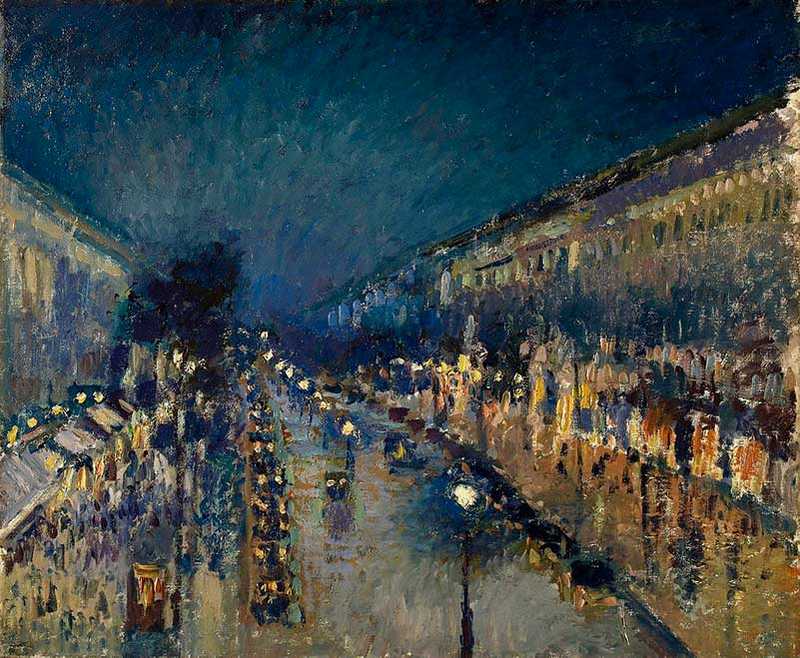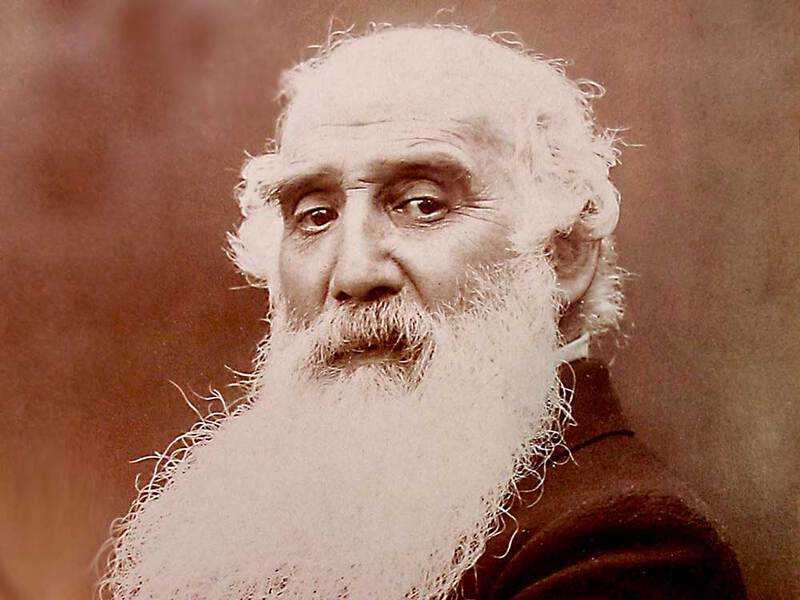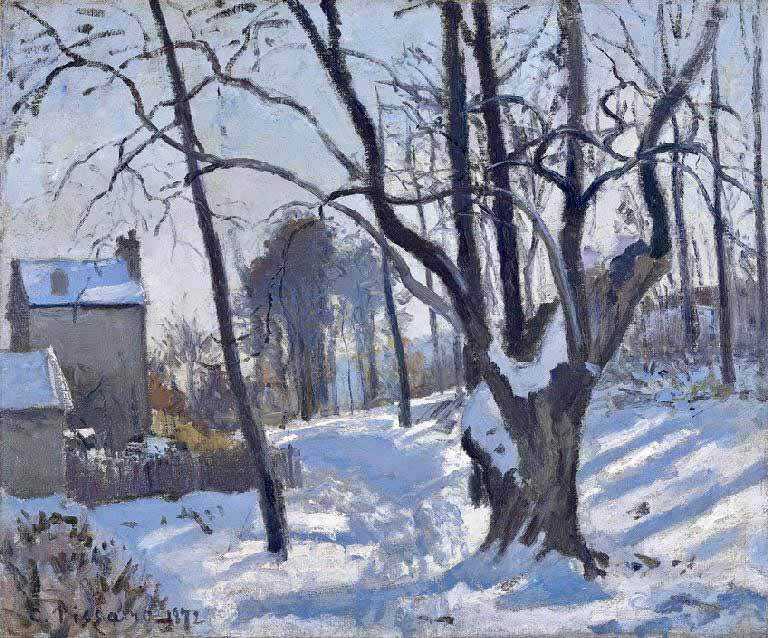1. View from Louveciennes (1869-70)
In 1869, Pissarro and his family moved to Louveciennes.
They arrived in the springtime and it is possible that this painting was made shortly after their arrival or perhaps the following spring, judging from the apple blossom.
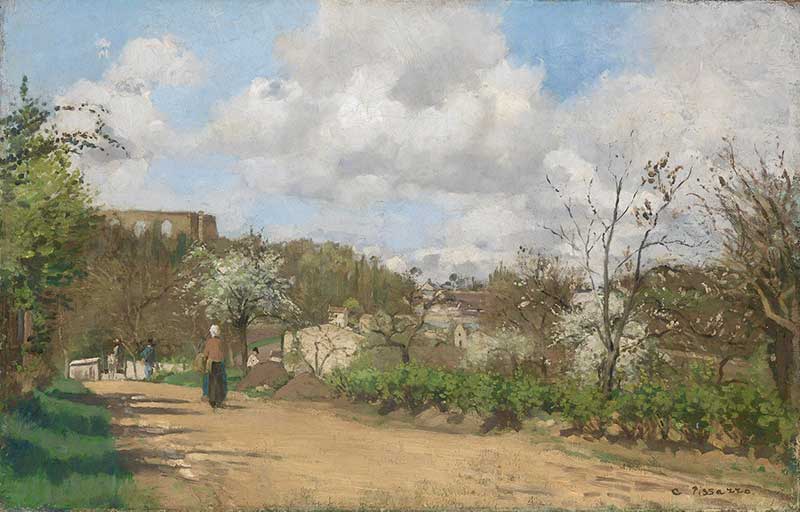
At this time, Sisley was also living in Louveciennes and Pierre-Auguste Renoir’s family had a summer home close by.
The composition of the painting is arranged in strips, with the road and row of bushes forming the lower portion, topped by the hills and the aqueduct and then the cloud-filled sky. Some figures are also present in the scene but they are roughly defined so the focus remains on the overall landscape.
In this painting, there are parallels to the work of Corot, both in the colour palette and the undulating effect of the landscape. Corot used horizontal layering techniques to build his paintings, electing a bright colour palette to give them a more poetic atmosphere.
Pissarro created the same effect using a series of small brushstrokes, giving his piece a uniquely Impressionist feel, while using a range of brown and yellow tones.
2. The Avenue, Sydenham (1871)
Painted while Pissarro was in exile with his family in London, ‘The Avenue, Sydenham’ is a wonderful example of Pissarro’s earliest works, characterised by clean lines and bright colours.
He drew inspiration from the paintings of French landscapist Camille Corot, mixing his paints with white to create consistently light tones throughout the piece.
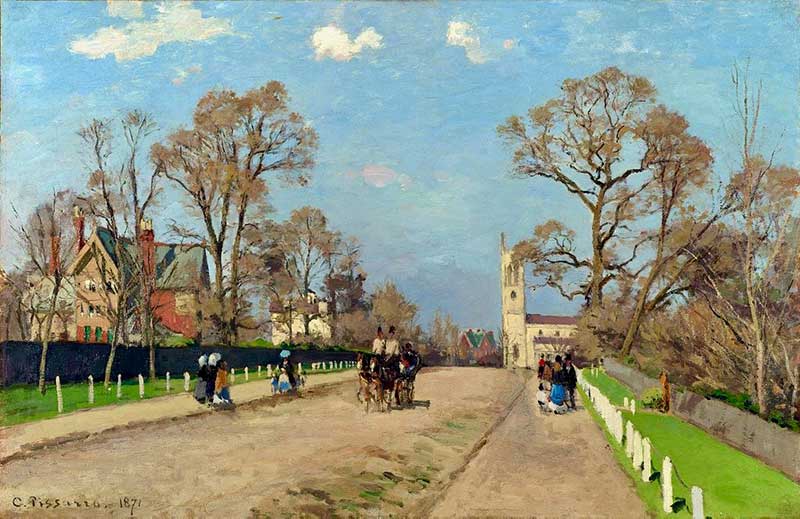
The perspective of the painting is fairly traditional, featuring a receding lane which was a common feature in Neo-classical landscape paintings. The motif is also simplistic and respectable, depicting a genteel residential street with well-dressed people promenading along. This can be seen as a deliberate choice on behalf of Pissarro to make his work more appealing to English tastes.
Reflecting on the painting later, Pissarro explained: ‘there is a striving for unity in it that fills me with joy’. He also described how,
"Monet and I were very enthusiastic over the London landscapes […] Monet worked in the parks, whilst I, living in Lower Norwood, at that time a charming suburb, studied the effect of fog, snow and springtime."
Many of Pissarro’s paintings from England were exhibited by Paul Durand-Ruel at the New Bond Street Gallery in 1871. Durand-Ruel was one of the first individuals and art dealers to recognise the potential of early Impressionist art and support the artists in their endeavours.
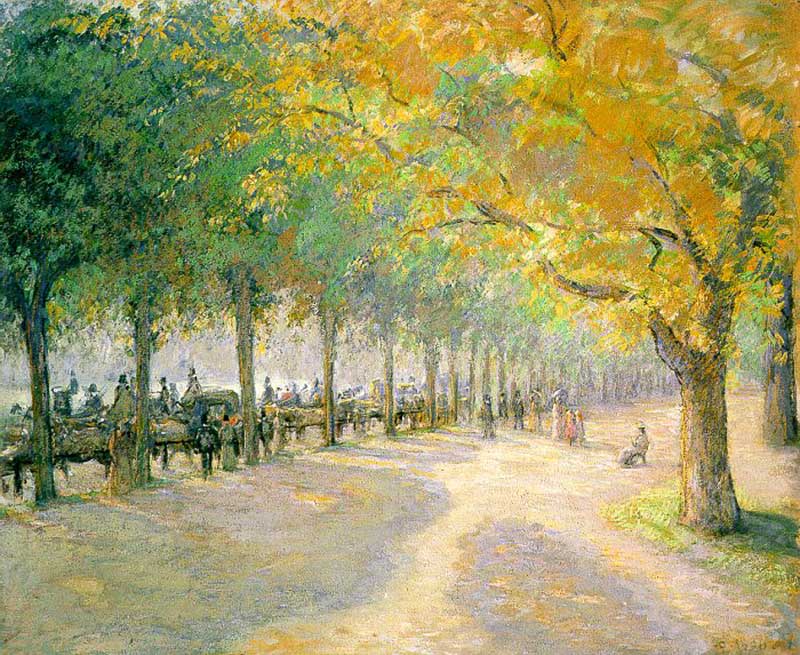
Durand-Ruel purchased ‘The Avenue, Sydenham’ and four more of Pissarro’s paintings from this time.
3. Piette’s House at Montfoucault: Snow Effect (1874)
Like many of the Impressionists, Pissarro was drawn to snowscapes as a way of exploring the subtleties of natural light in a winter landscape.
Throughout his career, Pissarro painted a wide range of snowscapes, venturing out into the cold in his youth and later painting snowy scenes from his window.
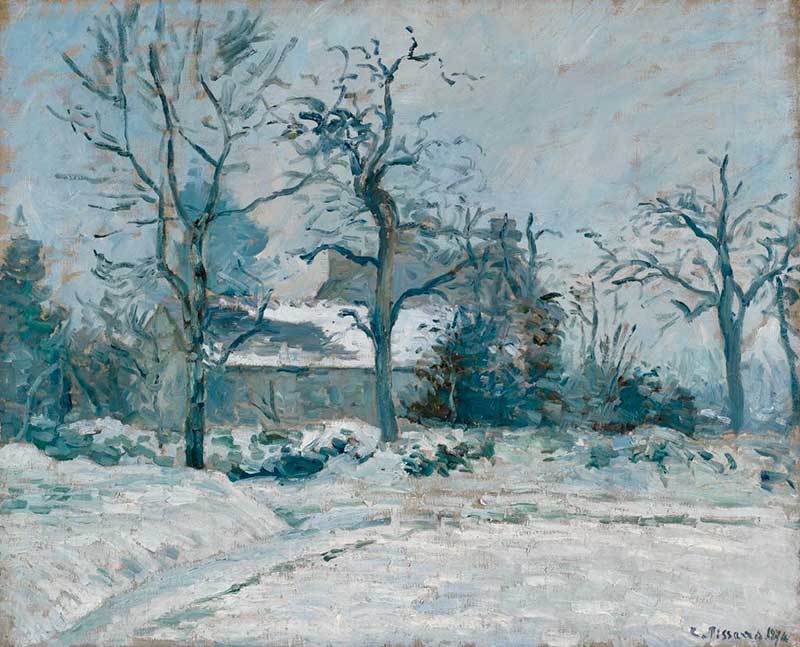
This particular piece was painted while the artist was staying with fellow painter and friend Ludovic Piette-Montfoucault at the Montfoucault estate in Mayenne. He visited the estate regularly and embarked on a series of works in the autumn of 1874.
Pissarro described the setting as “the true countryside” and he was enthusiastic about capturing the rural beauty of his friend’s home.
Of the 18 paintings Pissarro painted during his visit, five were snowscapes. In ‘Piette’s House at Montfoucault: Snow Effect’ (1874) we can see his use of different shades of white and grey to capture the wintry scene.
Writing about Pissarro’s snow paintings, Charles Moffett observed,
“Despite the wide variety of content and composition, these winterscapes have in common Pissarro’s enduring love of nature, his great fascination with light and shadow, and his interest in humanity”.
Another example of Pissarro’s mastery of snowscapes is ‘Fox Hill, Upper Norwood’, painted while Pissarro was in London during the Franco-Prussian War. This piece is notable for the strong tonal contrast between the brightness of the sky and the dark shadows of the houses and trees, as well as the bright flecks of colour used to pick out small details.
4. The Côte des Bœufs at L’Hermitage (1877)
‘The Côte des Bœufs at L’Hermitage’ is an interesting piece in Pissarro’s oeuvre as it shows his early interest in a more structured approach to Impressionism.
During the 1870s, the Impressionists were largely focussed on capturing fleeting moments, painting works quickly and often in a single sitting. While Pissarro had adopted many of these stylistic techniques, he also expressed a wish to create more technically complex works.
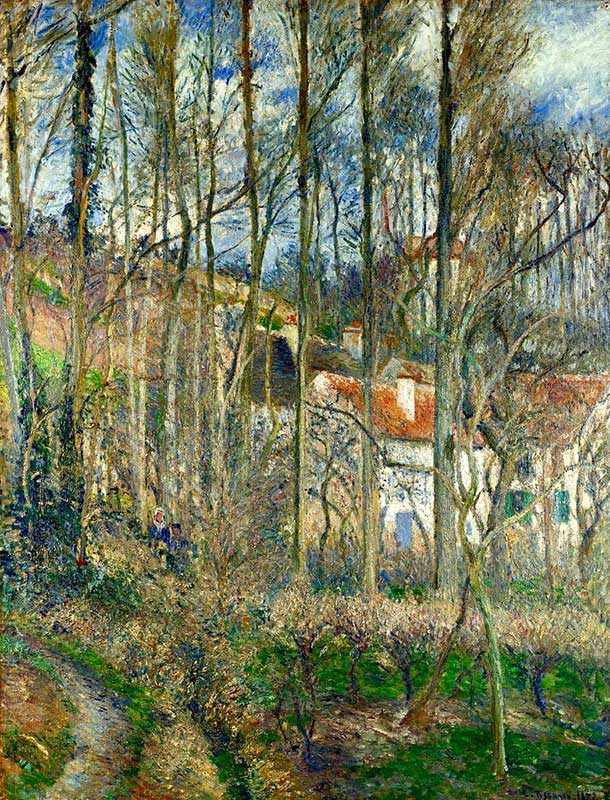
‘The Côte des Bœufs at L’Hermitage’ is an example of a more complex painting, both in its composition and execution.
The painting is dominated by a dense fabric of interweaving tree trunks and branches with thick scrub in the foreground. Beyond, a collection of neat buildings can be seen. There are also two figures to the left of the painting. The inclusion of figures in a landscape are characteristic of Pissarro’s work.
To create the textures of this piece, Pissarro applied the paint in a series of tiny brushstrokes. The paint was so thick in parts that the canvas had to be reinforced in order to bear the weight. This gives the work a highly textured surface that echoes the rough texture of the tree bark he depicts.
This scene was painted in L’Hermitage, a hamlet close to Pissarro’s home where he lived between 1866 and 1883. Pissarro painted a large number of canvasses in nearby Pontoise and the surrounding area, enjoying the wide range of rural subjects.
5. Young Peasant Having Her Coffee (1881)
‘Young Peasant Having Her Coffee’ is reminiscent of works by other Impressionist artists such as Caillebotte and Degas, depicting women going about their daily activities in an unconscious way.
What is notable about Pissarro’s work however is that he chose to paint rural labourers rather than focussing on Parisians.
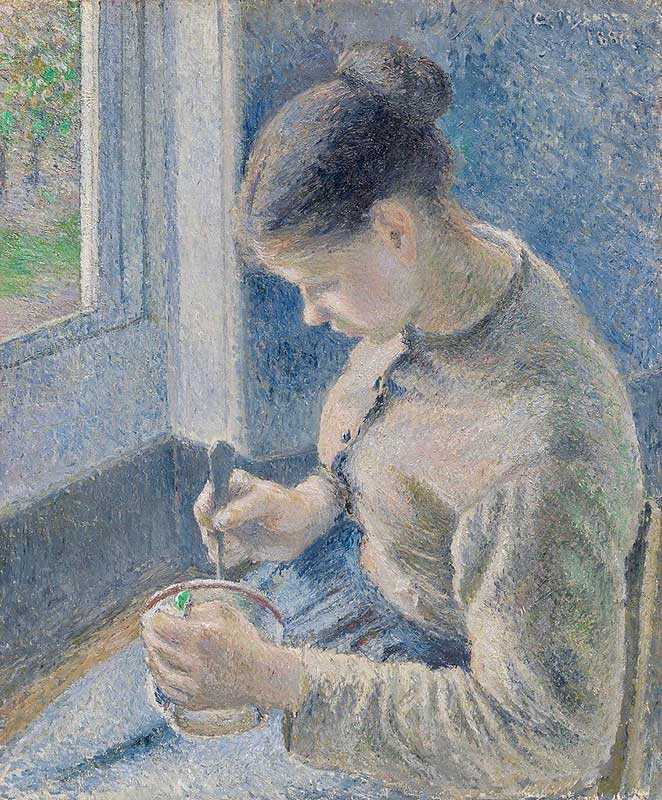
The way in which he applies the paint to the canvas is also unique. Pissarro used very small brushstrokes to build up the piece, applying daubs of thicker paint on top. By creating a textured surface, Pissarro sought to mimic the rough texture of the woman’s clothing.
Pissarro was interested in the way paint could be used to evoke the physical and social world it was depicting. Drawing on the work of the French Realist painter Gustave Courbet, he experimented with different textures.
He felt that rougher textures were more appropriate for paintings of rural life, in contrast to the highly finished and glazed works that were common in academic painting.
This piece can also be seen as part of a wider mission by Pissarro to preserve the image and values of an agrarian society. As an artist with anarchist ideals, his paintings always portrayed rural workers in images that showed their dignity and contentment.
This piece was one of a number of paintings of peasant women that Pissarro exhibited at the Seventh Impressionist Exhibition of 1882.
6. Late Afternoon in Our Meadow (1887)
Pissarro met neo-impressionist painters Georges Seurat and Paul Signac in 1885.
This meeting prompted a shift in his painting style as he began experimenting with Pointillist techniques, which utilised colour theory to create highly complex artworks.
Pissarro’s take on the technique can be seen in ‘Late Afternoon in Our Meadow’.

In this painting, Pissarro builds up dots of complementary colours to create the impression of a summer’s day in the countryside.
Yellows and oranges denote the areas of the meadow that are bathed in sun while daubs of blues and purples indicate shadow. The closer you look at the painting, the more variety of colour you can see.
As art historian and descendant of Pissarro, Joachim Pissarro described:
"His representations of these fields and gardens constitute the most spectacularly intense pictorial effort to ‘cover’ a particular given space in his career.”
As well as using juxtaposing colours to build up the scene, Pissarro also creates a sense of form through the direction of his brushstrokes. Horizontal marks make up the landscape while more irregular, vertical brushstrokes build up the foliage of the trees. For the sky, the brushstrokes are curving, giving the impression of summer clouds and bright light.
Pissarro painted views of this meadow several times after moving with his family to the village of Eragny in 1884. He stayed in Eragny for the rest of his life, travelling to neighbouring cities to paint but always returning to the peace of his rural home.
This scene conveys a sense of that peace, helping by the long shadows across the field and the solitary figure, resting with her hand on her hip.
7. Prairie avec vaches, brume, soleil couchant à Éragny (1891)
A glowing and glorious painting, ‘Prairie avec vaches, brume, soleil couchant à Éragny’ depicts a meadow at sunset with a line of trees in full leaf and the subtle outline of a herd of cows grazing calmly.
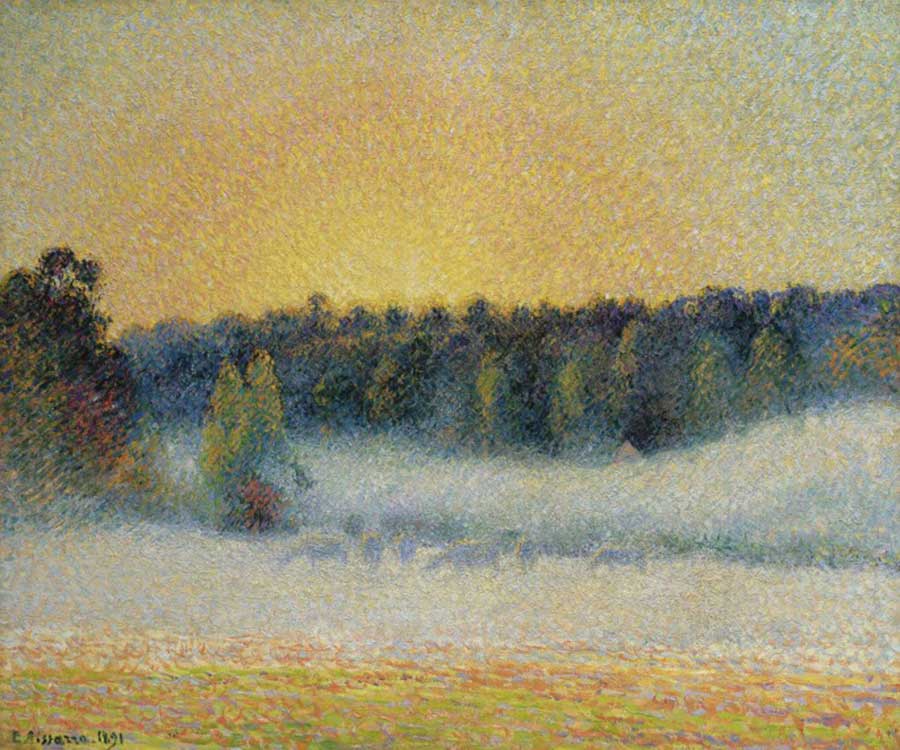
From this painting, it is clear to see the influence of Pointillism on Pissarro’s work. The piece is made up of tiny spots and flicks of contrasting colours which merge together to create the overall impression of a rich summer sunset.
For the sky, Pissarro spread out his brushstrokes in a fan-like effect, emanating upwards from the tree line to express the feeling of the setting sun.
In a description that is almost as beautiful as the painting itself, the critic Clément Janin wrote in L’Estafette:
”M. Pissarro hardly ever uses the brush any more, only the knife, […] to give more scope to the dazzle of light in the compositions he paints. The asperities he multiplies serve to capture and trap the rays of light and when the sun shines forth the colours suddenly sparkle like a jeweller’s window.” He went on to describe the sunset, "where the ebbing daystar sinks like a luminous fire bomb into the jewel-like radiance of the west, behind a forest in its mourning weeds of dark amethyst”.
The painting was exhibited in the Galerie Durand-Ruel in Paris in 1892 as part of a solo exhibition of Pissarro’s work. Eventually the piece was sent to the Durand-Ruel’s gallery in New York where it was purchased and owned by a series of American collectors.
8. Boulevard Montmartre (1897)
Some of Pissarro’s most impressive paintings belong to his Boulevard Montmartre series, depicting 14 different views of the new, modern Parisian boulevard.
Painted from a hotel room on the Rue Drouot, Pissarro captured the boulevard in a wide variety of different weather conditions and times of day.
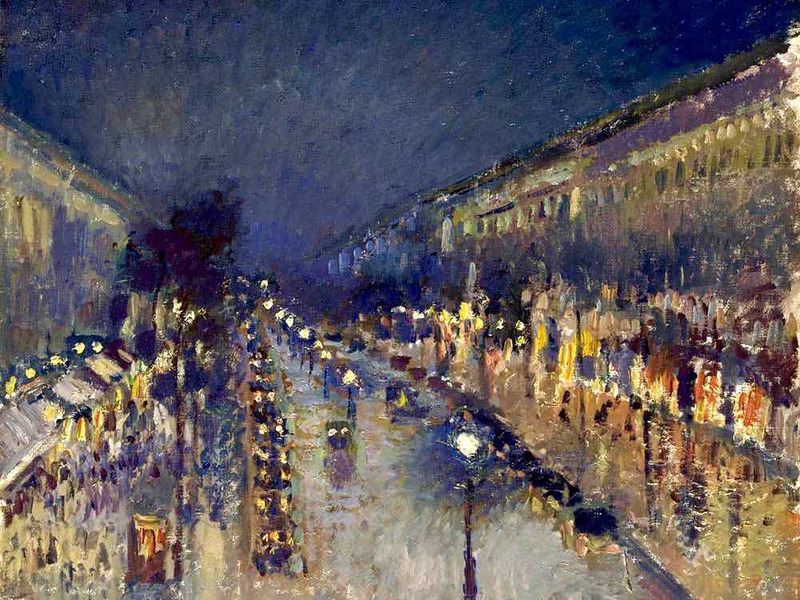
These paintings are stunning, not just for their attention to detail but also for the atmosphere that they evoke. In one painting, the Boulevard Montmartre is packed full of people celebrating a festival, in another it is lit by street lamps on a dark night and another sees daily life on the boulevard on a spring day.
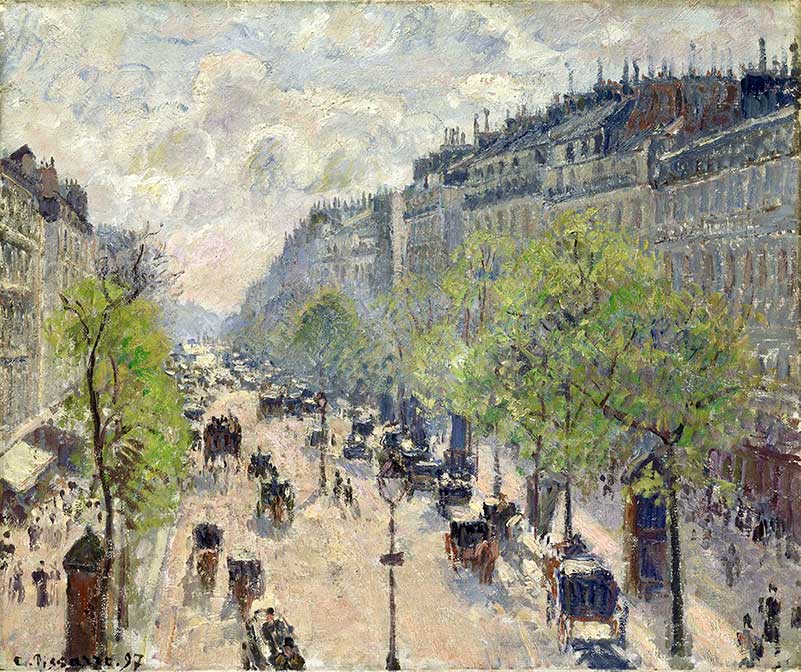
Pissarro brings the viewer into the scene so that it feels as though you are observing the street exactly as it was in the late 19th century.
As well as being hugely atmospheric, the paintings are also technically masterful. Pissarro relished in the challenge of painting the perspective of the street from such a high vantage point. As he wrote to his son Georges,
“I have another motif which is terribly difficult, almost as the crow flies, looking over the carriages, buses and people milling about between the large trees and big houses which I have to set up right – it’s tricky […] it goes without saying that I must solve it all the same.”
Pissarro may have drawn some inspiration for the series from the work of Japanese artist Hiroshige. His street scenes were extremely popular in Europe during this period and the Impressionists frequently built on Japanese art styles in their paintings. The series was exhibited at Durand-Ruel’s Paris gallery in 1898.
Learn more on our Boulevard Montmartre page.
9. Tuileries Gardens (Winter Afternoon) (1899)
There are a total of six paintings by Pissarro of the Tuileries Gardens, all painted in a period of just a couple of years.
This series includes the Tuileries in both the winter and the spring, capturing the changing atmospheric conditions through the seasons.
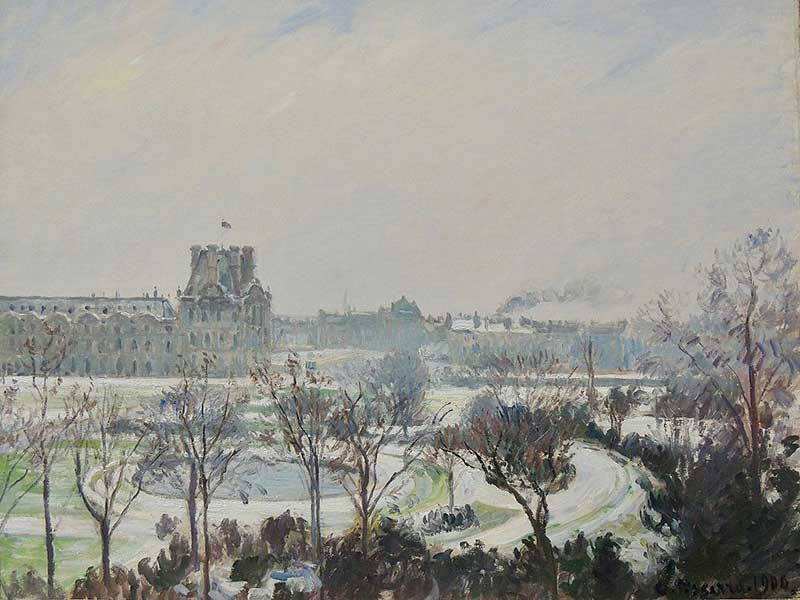
‘The Garden of the Tuileries on a Winter Afternoon’ shows the scene under a watery winter sky, the trees almost completely bare and the park filled with people. Pissarro paid particular attention to the effects of the weak sun on the cloudy sky, capturing the pale yellow highlights among the soft grey of the clouds.
Pissarro wrote to his son in 1898, describing the “superb view of the Park” from the apartment he had rented overlooking the Tuileries, with
“the Louvre to the left, in the background the houses on the quays behind the trees, to the right the Dôme des Invalides, the steeples of Sainte-Clotilde behind the solid mass of chestnut trees.”
He was greatly inspired by the scene.
This particular painting was given by Pissarro to the children of Alfred Sisley on January 29th, 1899 to help them financially following their father’s death.
It was later purchased by Durand-Ruel and exhibited at his gallery in Paris in 1901.
10. The Seine and the Louvre (1903)
From 1893 onwards, Pissarro shifted his focus to urban scenes for his paintings.
He began painting the industrialised landscape of modern Paris, Rouen, Le Havre and more. In doing so, Pissarro moved away from the countryside sites of his earlier work.

The Seine and the Louvre became popular subjects in Pissarro’s paintings during this period. Unlike the busier boulevards and train stations in the city, the Seine and the Louvre offered a quieter, more contemplative motif.
For this particular piece from 1903, Pissarro executed the painting from the window of a house in the Place Dauphine, setting up his canvas in a room on the second floor. In total he painted around 30 works from this position between 1900 and 1903.
In ‘The Seine and the Louvre’, we see the river on a winter’s day. The colours are washed out and a light mist softens the harsh lines of the manmade structures. The effect of the water is produced through short, dappled brushstrokes while the colour in the sky is more diffuse. Towards the end of his life, Pissarro became particularly interested in painting sky and water scenes.

